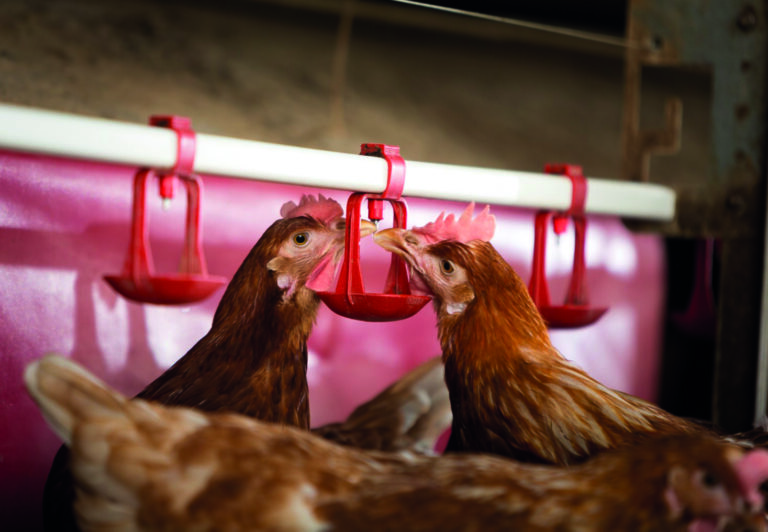Chloe Paine, Poultry Technical Manager at Trouw Nutrition GB explains the importance of keeping hens longer and the key role of nutrition in achieving this.
At Trouw Nutrition we adopt a holistic approach to sustainability, linking environmental and economic sustainability through production efficiency and enhanced lifetime performance. Keeping laying hens for longer is one way of driving down the carbon footprint of egg production (CO2/kg egg) through increased lifetime performance.
To focus on a longer laying cycle and increased efficiency it is important to improve feed and feeding techniques. Understanding the environmental footprint of poultry feed enables farms and feed mills to optimise their operations and reduce overall impact.
In layer production, the majority of greenhouse gas emissions are linked to feed formulation. The most direct way of reducing the impact of egg production is through the feed and better feed choices. Using feed formulation software equipped with feed environmental footprinting means formulations can be optimised to reduce the footprint. However, this should not be done as a standalone practice. To drive down carbon footprint (CO2/kg egg), it is essential to improve production efficiency.
The primary goal of the diet is to meet the nutritional requirements of layers as efficiently as possible, matching nutrient levels to requirements and selecting the optimum raw materials. At Trouw Nutrition we focus on meeting the precise requirements for production, health and longevity, delivering the correct nutrients in the correct amounts at the correct time. We also focus on egg quality, particularly eggshell quality, as its decline is a major reason for flock depletion. To address this, we work with producers to concentrate on the areas and stages of production where layers require the most support.
Managing for target egg weight throughout the laying period is essential as controlling egg weight helps avoid problems at later ages that threaten overall cycle length. Adjusting digestible amino acid density through phase feeding and formulating based on amino acid density rather than crude protein targets are effective strategies. Reducing crude protein levels and including higher levels of synthetic amino acids, reduced in a safe and balanced way so as not to compromise performance, can lower nitrogen emissions, contributing to improved sustainability.
Knowledge of amino acid requirements and dietary amino acid supply is crucial for reducing the crude protein content of the diet. Close collaboration between nutritionists and farms and careful monitoring of feed intake are also important, so that diet density can be adapted to avoid nutrient intake drops or over supply.
Eggshell formation is a demanding mineralisation process. The requirement for calcium is high and cannot be met by feed supplied calcium alone. This triggers that the hen draws calcium from her calcium reserves, the medullary bone. Relying on too much use of the medullary bones leads to a loss of phosphorus and bone strength which does not support long life layers, nor the environment, so understanding feed and feeding techniques becomes important.
Due to the time an egg is laid and the length of time the developing egg spends in the shell gland, shell formation occurs mostly during the night in the absence of feed intake, and thus dietary calcium. To keep layer hens longer it’s important to pay attention to maximising the absorption of calcium. Ensure the correct level of dietary calcium at each phase of lay, adjusting for hen age and feed intake. Calcium absorption and utilization decreases with age, but increasing dietary calcium beyond a certain point can reduce absorption efficiency, meaning increasing dietary calcium concentration has upper limits.
To increase the amount of calcium available at night to improve eggshell quality we need to ensure the correct particle size of the calcium at each phase of lay with a balance of fine and course limestone.
Additional support to the hen can be provided by adopting a split feeding strategy, where hens are fed a morning diet and an afternoon diet with different nutrient levels, especially calcium and phosphorus. The system supports specific nutrient requirements and timing, improving performance and sustainability. Hens consume less feed and use nutrients more efficiently, resulting in fewer nutrients lost and reduced CO2 footprint.
Increasing longevity involves a multifactorial approach beyond feed formulation. A healthy gut and a healthy liver ensure optimal nutrient and mineral absorption and are essential for shell quality. Along with calcium, micro-minerals including zinc, manganese and copper influence eggshell quality. Supporting gut health and liver health is good practice and can enhance eggshell quality.
Sustainable layer production requires attention to detail in feed management, nutrient requirements, egg quality and overall hen health. These practices contribute to environmental sustainability through reducing emissions and improving resource utilisation, while enhancing production efficiency and egg quality.


